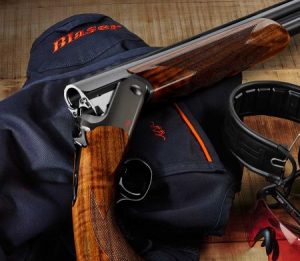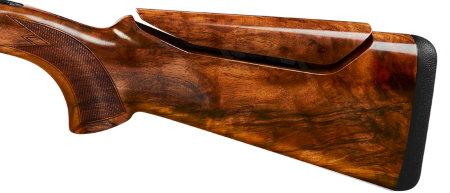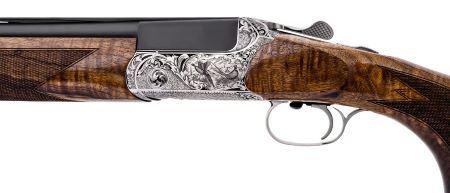The Blaser F16 is Your Mid-Priced Clays Secret Weapon

Ask your shooting buddies about the best new clays gun to buy for about $5,000 and they’ll probably rattle off the usual suspects: Beretta, Caesar Guerini, Rizzini or Zoli. Chances are you won’t hear about, perhaps the best shotgun in the category, the Blaser F16 Sporting.
Since its introduction in 2016 (hence F16) in both a Sporting and Game models, the Blaser F16 has lived in the shadows of the original Blaser brought into the U.S., the F3. When Blaser introduced Americans to the F3 in 2004, the shotgun was hailed for its ultra-low profile, unique horizontal hammers called strikers, barrel-swapping modularity, intuitive mechanical triggers and German exactitude.
 The receiver of the Blaser F16 Sporting.
The receiver of the Blaser F16 Sporting.
Although the Blaser F3 had always been priced several thousand below premium clays crushers from Perazzi, Krieghoff, Kolar and Beretta, it ranked as an exceptional performer that was actually capable of competing against the more expensive thoroughbreds. With the help of an aggressive marketing campaign and tournament podium placements, the Blaser F3 soon became a preferred choice among the serious campaigners who found the shotgun to be a brilliant shooter.
But some enthusiasts enamored with the Blaser F3 found themselves financially shut out of the brand. It took Blaser GmbH of Isny, Germany a few years to respond, ultimately with the Blaser F16 arriving in America as a more affordable sibling. It has a suggested retail price of $5,792 for the Blaser F16 Sporting Standard with Grade 4 wood and $6,449 for the adjustable comb version.
Once the Blaser F16 received the go-ahead in Germany, designers took a cost-effective approach to integrating strategic Blaser F3 innovations.

The F16 “monocoque chassis” resembled the one on the F3. By monocoque, think of an airplane frame where the aluminum skin provides virtually no structural support in a configuration that’s light and resilient.
Whereas the Blaser F3 employs a locking underlug that contributes to the low profile. The bottom barrel is cut into the underlug notch, letting the over/under set sit extremely low in the CNC-machined steel receiver. Likewise, the underlug bite on the monobloc closes through a rectangular hole on the floor of the receiver – making it dramatically lower by fitting that bite lump flush with the receiver bottom.
In a cost-cutting alternative, the Blaser F16 has a bifurcated underlug that hooks the monobloc on both ends, supplemented by lumps on the receiver’s interior walls. Likewise, the Blaser F16 has a single cocking rod in the floor of the receiver while the Blaser F3 has two.
The Blaser F16’s trigger-plate action is removeable. Unlike the F3’s linear strikers, the F16 uses conventional hammers but with short, vertical coil springs instead of the conventional horizontal.
Blaser’s F16 receiver measures 60mm tall and 42mm across. For handling, the F16 has rounded bottom edges. With its low center of gravity and slightly wide beam, the Blaser F16 delivers a swing that I call “decisive” rather than the well-worn catchphrase of “intuitive.”
 Blaser’s F16 Game shotgun.
Blaser’s F16 Game shotgun.“Intuitive” implies a neutral and fast handling shotgun that seems hardwired to the human pointing instinct. “Decisive,” meanwhile, provides a certain mechanical gravitas that feeds your confidence – something that “intuitive” shooting doesn’t necessarily convey – especially in low-gun shooting such as sporting clays. The “decisive” factor can best be described as the power steering in a high-performance car versus a truck or crossover runabout.
Neither whippy nor barrel-heavy, the Blaser F16 delivered an effective balance of swing and control from hold point to break point. Hangers between the barrels that are hidden by the forend accommodate small, optional weights that can add up to 1½ ounces total to customize the balance point.
 The Blaser F16 Heritage.
The Blaser F16 Heritage.Shooting clays with the Blaser F16 speaks to affordability through engineering – truth in manufacturing. That’s why the Blaser F16 Sporting is so handsomely unpretentious with its plain satin-finished charcoal grey receiver and a spark of F16 in red.
The shotgun’s wood-to-metal fit was gap-free and slightly proud.
Blaser’s F16 budget objectives were helped by sourcing technology from the F3. The proven Ejection Ball System (EBS) of the Blaser F3 cocks the F16’s ejectors only when the shot is fired, eliminating tension after ejecting the hulls. Blaser’s EBS has another distinct advantage: you don’t have to force their shotguns closed right before a shot to cock the ejectors. In the field, the EBS contributed to a more relaxed and single-minded shooting experience.
The EBS has a big payoff for owners of new over/unders. How many times have you bought a shotgun and out-of-the-box that’s difficult to close? We routinely accept this annoyance as a breaking-in period, which could last for years. Blaser’s EBS eliminates that hassle.
 The adjustable comb on the Blaser F16 Sporting.
The adjustable comb on the Blaser F16 Sporting.In addition, Blaser included the F3’s Inertial Block System (IBS) into the F16. The IBS enhances shooter safety and comfort by preventing the shotgun from fan firing or doubling.
Devotees of the Blaser F3 will be glad to know that its wonderful mechanical, selectable trigger has been fitted to the Blaser F16. At 3.6 pounds of pull, the draw is smooth, precise and intuitive. Blaser also adopted the F3 palms swell to its F16. The recoil pad has rounded corners to help avoid vest snags from the ready position.
 The stock of the Blaser F16 Sporting standard model.
The stock of the Blaser F16 Sporting standard model.The satin finished barrels feature the Blaser F3’s Triplex Bore Design of elongated forcing cones. Inside, the barrels are steel-proofed and chrome finished. The Blaser F16, like the F3, ships with Briley Spectrum extended chokes. You’ll find a fluorescent bead on the muzzle and a steel bead mid-rib.
For a clays gun, the Blaser F16 might be considered a tad light at 7½ pounds (depending on barrel length of 30 or 32 inches).
The trigger is selective via a lateral toggle on the bottom of the receiver immediately in front of the trigger blade. The manual safety is a traditional slider mounted on the top strap.
The Blaser F16 shares the F3’s standard Grade 4, satin-finished walnut. The slender forend of the Blaser F16 Sporting should fit nearly all hand sizes and contributed to positive pointability. And like the Blaser F3 clays shotguns, the F16 pistol grip has a palm swell for greater comfort and control. Combined, the furniture worked in tandem for direct point-where-you-look target acquisition essential to presentations such as seriously fast crossers.
Out of the box, I found the Blaser F16 with 32-inch barrels delivered a flat, 50/50 line-of-sight. I subsequently altered the comb to approximately 70/30. The included Allen wrenches made the adjustment fast and easy. As a quick note, many shotgun combs use two elevation screws that need to be the same height (if that’s your preference), fine-tuned through trial and error. By comparison, the Blaser F16 has a single set screw for elevation that made the alteration a snap.
 A Game Luxe edition of the Blaser F16.
A Game Luxe edition of the Blaser F16.I shot 5-Stand with the Blaser F16 at The Ranges at Oakfield, in Shotgun Life’s hometown of Thomasville, Georgia – in the heart of bobwhite quail country. The course was challenging: quartering-away rabbits, extremely fast chandelle, dropping and quartering incomer and a diving overhead among others, including several long incomers.
The Blaser F16 shouldered in a balanced manner, aided I believe by the palm swell. On shooting report and simultaneous pairs, the Blaser F16 swung with a sense of control that curbed any urgency in transitioning to the second target. The confidence-inducing ergonomics and responsive trigger seemed to embody the shooting adage “slow is smooth and smooth is fast.”
Using 1⅛-ounce, 1,200 feet-per-second shells, felt recoil was near-zero. Aside from delivering a comfortable experience, low felt recoil also aids with a focused move to the second target of a pair; your eyes and face aren’t jarred, and the post-shot stability of the first target can accelerate the acquisition of the second for a pair of clean breaks.
After returning the Blaser F16 to its case, you can’t be faulted for thinking of the shotgun as “a poor man’s F3.” And if you don’t need the multi-barrel modularity or some of the cool technology of the Blaser F3, it’s a logical jump to the less expensive F16. As an effective clays shotgun, you won’t feel deprived or disappointed by opting for the F16 over the F3.
Since 2016, Blaser has rounded out the F16 offerings with the addition of Heritage and Grande Luxe models. Beautifully engraved sideplates and upgraded wood raise the appearance of the F16, and of course the overall value proposition of the base models – where the Blaser F3 may seem like a more attractive choice.
I wouldn’t go out on a limb and say the Blaser F16 is in a class of its own, but the lineage to the excellent Blaser F3 is an attribute that’s clearly felt and appreciated.
Irwin Greenstein is the publisher of Shotgun Life. You can reach him at contact@shotgunlife.com
Helpful resources:
Web site for the Ranges at Oakfield

Irwin Greenstein is Publisher of Shotgun Life. Please send your comments to letters@shotgunlife.com.


Comments